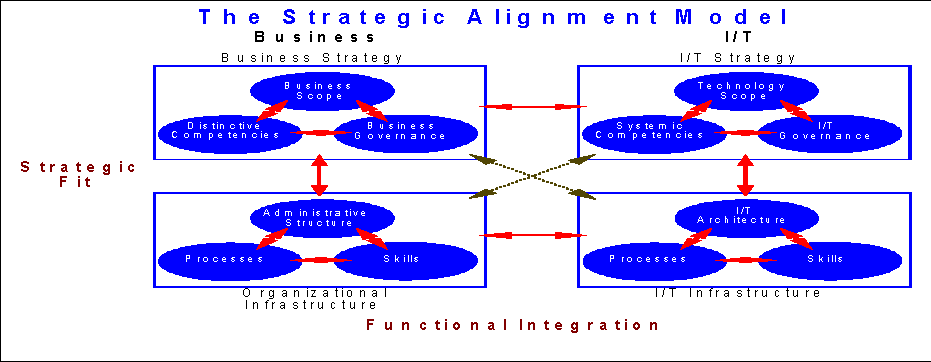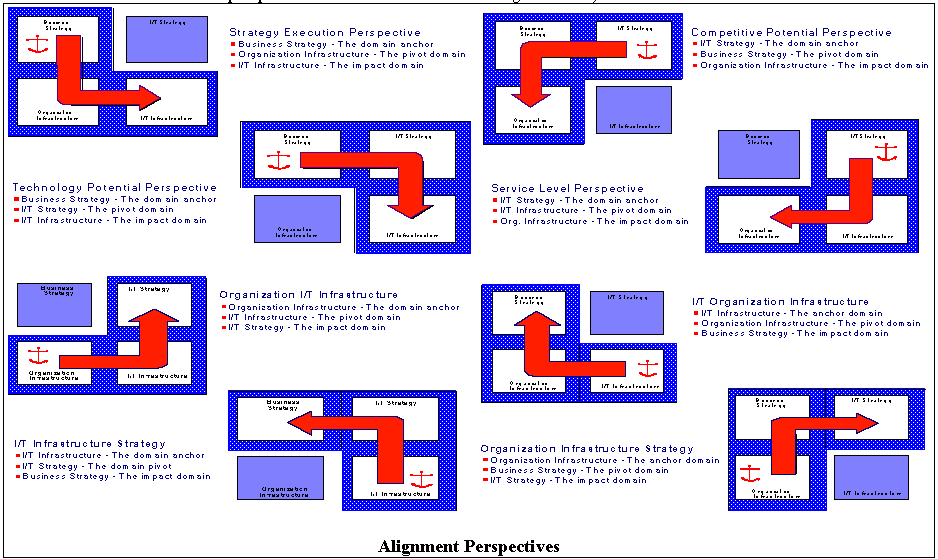
This research describes the results and findings from a two-year study of strategic alignment. Executives from over 300 firms representing 15 industries attended classes at IBM's Advanced Business Institute during 1992-1994. They asked for help in assessing strategic alignment within their companies. A computer-based tool was used to evaluate alignment within these firms.
Eight new alignment perspectives were validated, along with the four original perspectives from the Strategic Alignment Model. A pre- and post-assessment comparison suggests that executives often do not correctly recognize their firm's alignment perspective and the role I/T can play in meeting business objectives. These findings emphasize the need to assess business and I/T using the alignment perspective approach to maximize the investment of I/T resources within the firm.
Results also suggest that the relationship between these perspectives on title/function, industry and firm performance directly affects the firm's alignment. Analysis of title/function indicates that I/T executives are concentrating on the business side (e.g. competitive potential and organization infrastructure fusion) while non-I/T executives are focusing more on technology (e.g. business-related perspectives such as technology potential and I/T infrastructure fusion). Industry analysis indicates that firms in certain industries tend to follow specific perspectives more often.
Assessment of the impact of financial performance results in 7 factors that have varying degrees of impact on alignment. The factors provide management with a vehicle to predict the likelihood of achieving positive performance regarding a given factor.
The computer-based assessment tool developed by Luftman and Brier (based on work by Henderson and Thomas, 1992) is used to assess the alignment of business and I/T in firms. The purpose of the model is to help firms identify areas of strength and weakness related to alignment. Information provided by the model enable firms to evaluate, achieve, and maintain alignment.
The strategic alignment model, the framework for our study, is based on the theoretical construct developed by J.C. Henderson and N. Venkatraman, now with Boston University. This model explores the interrelationship between business and I/T, illustrated in the figure below. Effecting a change in any single domain requires the use of three out of the four domains to assure both strategic fit and functional integration are properly addressed.
The assessment of alignment begins with a review of the firm's overall strengths and weaknesses using a set of directed questions. From the analysis of these questions, the firm's perspective can be determined. The traditional assessment approach (Luftman, Lewis, and Oldach, 1993; Luftman, 1995) uses a three-step process. The strongest domain, or anchor, is the driver of the change. The weakest domain, or pivot, is the area that is to be addressed. By identifying the strongest and weakest domains, it becomes possible to identify the area which will be affected by the changes. This third domain is the impacted domain. The direction the perspective flows is based on which domain is the strongest and which is the weakest. For example, if a company has a strong business strategy and the business infrastructure is weak, then the impacted domain will be I/T infrastructure and the flow is counterclockwise. This perspective is called the Strategy Execution perspective. Here the business strategy drives changes to the business infrastructure and processes. These changes will impact I/T infrastructure.

There are a total of twelve perspectives which include four fusion perspectives. The four original perspectives described by Henderson and Venkatraman (1990) include strategy execution, technology potential, service level, and competitive potential. The four new non-fusion perspectives are organization I/T infrastructure, I/T infrastructure strategy, I/T organization infrastructure and organization infrastructure strategy perspectives (see figure below).

Fusion, although not one of the eight perspectives with respect to the traditional anchor, pivot, and impacted domain construct, nevertheless uses these domains by combining two perspectives. In fusion, the pivot and the anchor domain are not adjacent to one another, but rather across from each other on the diagonal. Since there are two "paths" from the anchor to the impacted domain, it is necessary to identify the weaker of the two pivots and carry out this perspective first. Our research has not only identified and validated the eight previously described perspectives, but found that a combination of two perspectives--called Fusion--is common (Luftman, 1995)
Our research has found that the most common perspective focuses on both Organizational Infrastructure and I/T Strategy. This combination results in a fusion of two perspectives, Strategy Execution and Technology Potential, into I/T Infrastructure Fusion (Luftman, 1995). The fusion construct can be extended to include all eight previously described perspectives, resulting in four distinct types of fusion (see figure below).

Our research has found that most firms participating in the study did not recognize their positioning regarding alignment. Their actual perspective was often far different from the one chosen by them before the formal assessment and education about the model. For example, 59% of the firms believed they were following a Strategy Execution perspective when, in fact, only 6% were found to be doing so after formal assessment. This suggests that over 50% were focusing their attention on the wrong domain. A second example suggests that 16.4% of the firms focused on improving I/T infrastructure based on I/T Strategy. After assessment, only 3.6% of the organizations found themselves in this Service Level perspective. This suggests that over 13% of organizations do not always recognize the opportunity available from I/T. Often, business leaders have not recognized the role I/T can play in meeting business objectives. These findings emphasize the need to assess business and I/T using the alignment perspective approach to maximize the investment of I/T.
Executives were asked to rate the strength of alignment within their firm. Over 50% believed that their business and I/T strategies were properly aligned, 42% indicated that they were not, and 7% were unsure or had no opinion.
The key enablers to alignment included executive support for I/T (21.8%), need to participate in developing business strategy (16.2%); I/T leadership was the third enabler identified by both I/T (15.2%) and non-I/T executives (11.5%). The need for a close relationship between business and I/T was almost twice as important to I/T executives (7.6%) than business executives (3.9%), indicating that I/T believes there is a greater need to work closely with the business.
The inhibitors shed light on problems firms face as they strive for alignment. The primary inhibitor is lack of affiliation. Business and I/T seem to be headed in different directions, suggesting poor communication between them. Close behind is the need for I/T to prioritize its workload better. The problem associated with the traditional I/T backlog is further addressed by the third inhibitor to alignment--the failure of I/T to meet its commitments.
I/T executives believe the greatest problem in the achievement of alignment is the lack of a close relationship between I/T and business (20.7%). Business ranked this second (14.3%). The top inhibitor among business executives is poor prioritization by I/T (16%). This is also seen as a problem by I/T, however it is a distant second (14.6%). The next major inhibitor for I/T executives is lack of executive support for I/T (11.6%), which is ranked fifth (9.5%) by business executives.
The effect of firm performance on alignment was tested using eighteen separate financial measurements. These included Return on Investment (ROI), Return on Sales (ROS), the Current and Quick ratios (which measure short-term liquidity and solvency), Gross profit, pre-tax income, net sales, growth in earnings/share (EPS), income growth, sales growth, earnings/share for 1993 and 1994, and current and long-term debt-to-equity. The firm's reputation, based on the Fortune (1994) survey of management executives, and the firms' overall I/T budget were also used. The market value of equity divided by the book value of debt (M/B Ratio) and Z-score (composite performance measure) were used as long-term measures of performance. These measurements were chosen to provide a comprehensive analysis of performance, encompassing present and future factors.
A principal components factor analysis performed on these measurements suggested that firm performance was ALIGNED into 7 factors: Anticipated performance, Liquidity, Income, Growth, Net profitability, E arnings, and Debt-to-equity. These 7 ALIGNED factors were analyzed by perspective and industry with respect to firm performance. While this research does not provide for specific measurements of performance, it does provide a good general indicator of whether or not the desired financial performance factor is achievable given a specific perspective or industry. For example, if the goal is to maximize growth, and the performance for the perspective in question (e.g. technology potential) indicates that below average performance is likely, the manager can change plans accordingly by concentrating on a different performance factor or waiting until a favorable perspective is reached. Similarly, if the goal is to maximize earnings, and the performance for the industry in question (e.g. manufacturing) indicates that below average performance is likely, the manager can effect a change to the organization strategy by focusing on a different performance factor, given that the industry the firm competes in is fixed (Papp, 1995).
This performance criteria, while not absolute, does provide a strong indication of the likelihood of achieving the performance factor for a given alignment perspective within a specific industry. It predicts possible outcomes beforehand , saving valuable time and providing the manager with a powerful vehicle to project results.
This research provides vital empirical support for the Strategic Alignment Model and validates 12 perspectives. It also illustrates the need for increased and continued communication between business and I/T to facilitate alignment. The increasing strategic role of I/T precludes the need for alignment to enable the business and increase the profitability and competitiveness of the firm.
Henderson, J. and Thomas, J. (1992) Aligning business and information technology domains: Strategic planning in hospitals. Hospital and Health Services Administrative, 37, 1, 71-87.
Henderson, J., and Venkatraman, N. (1990) "Strategic alignment: A model for organization transformation via information technology." Working Paper 3223-90, Sloan School of Management, Massachusetts Institute of Technology.
Luftman, J., et. al. (1995 forthcoming) Managing in the Information Age: Practical Applications of the Strategic Alignment Model. New York: Oxford University Press.
Luftman, J., Lewis, P., and Oldach, S. (1993) "Transforming the enterprise: The alignment of business and information technology strategies." IBM Systems Journal, 32, 1, 198-221.
Papp, R. (1995) "Determinants of Strategically Aligned Organizations: A Multi-industry, Multi-perspective Analysis & Validation" Unpublished doctoral dissertation, Stevens Institute of Technology, Hoboken, New Jersey.